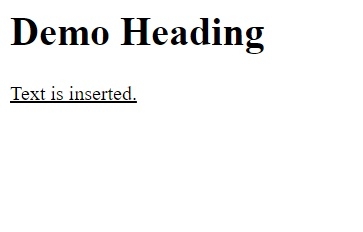
 Data Structure
Data Structure Networking
Networking RDBMS
RDBMS Operating System
Operating System Java
Java MS Excel
MS Excel iOS
iOS HTML
HTML CSS
CSS Android
Android Python
Python C Programming
C Programming C++
C++ C#
C# MongoDB
MongoDB MySQL
MySQL Javascript
Javascript PHP
PHP
- Selected Reading
- UPSC IAS Exams Notes
- Developer's Best Practices
- Questions and Answers
- Effective Resume Writing
- HR Interview Questions
- Computer Glossary
- Who is Who
HTML <ins> cite Attribute
The cite attribute of the <ins> element is used to set a URL that specified the reason to insert the text. Following is the syntax −
<ins cite="url">
Above, we have set url, which is the address to the document explaining the reason to insert the text. Let us now see an example to implement the cite attribute of the <ins> element −
Example
<!DOCTYPE html> <html> <body> <h1>Demo Heading</h1> <ins cite="new.htm">Text is inserted.</ins> </body> </html>
Output

In the above example, we have inserted a text using the <ins> element −
<ins cite="new.htm"> Text is inserted. </ins>
Above, we have set the reason of insertion using the cite attribute −
cite="new.htm

Advertisements
